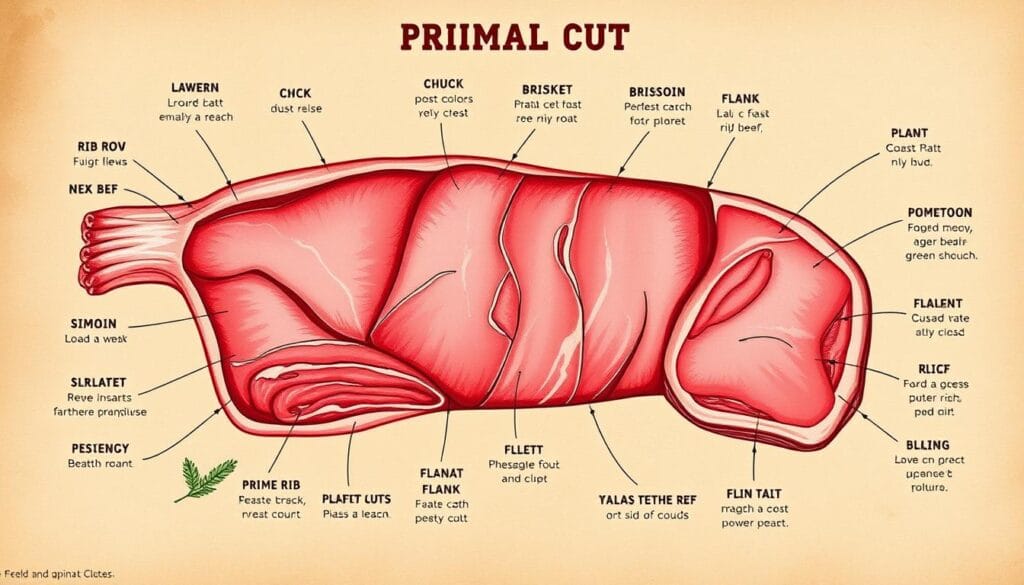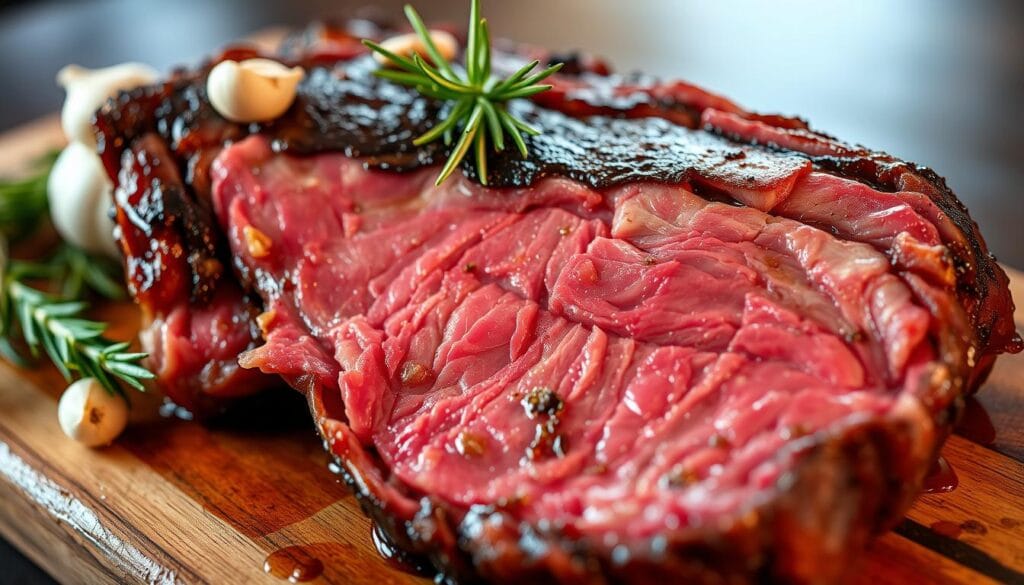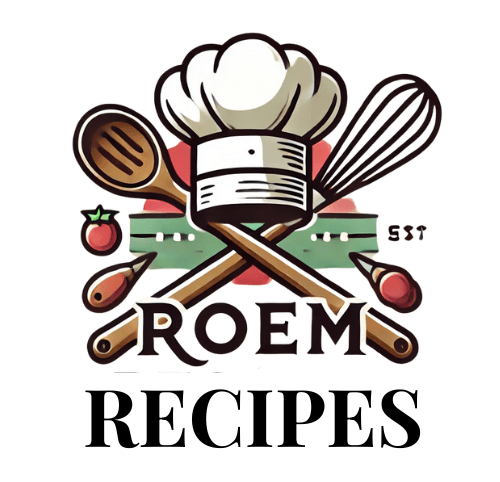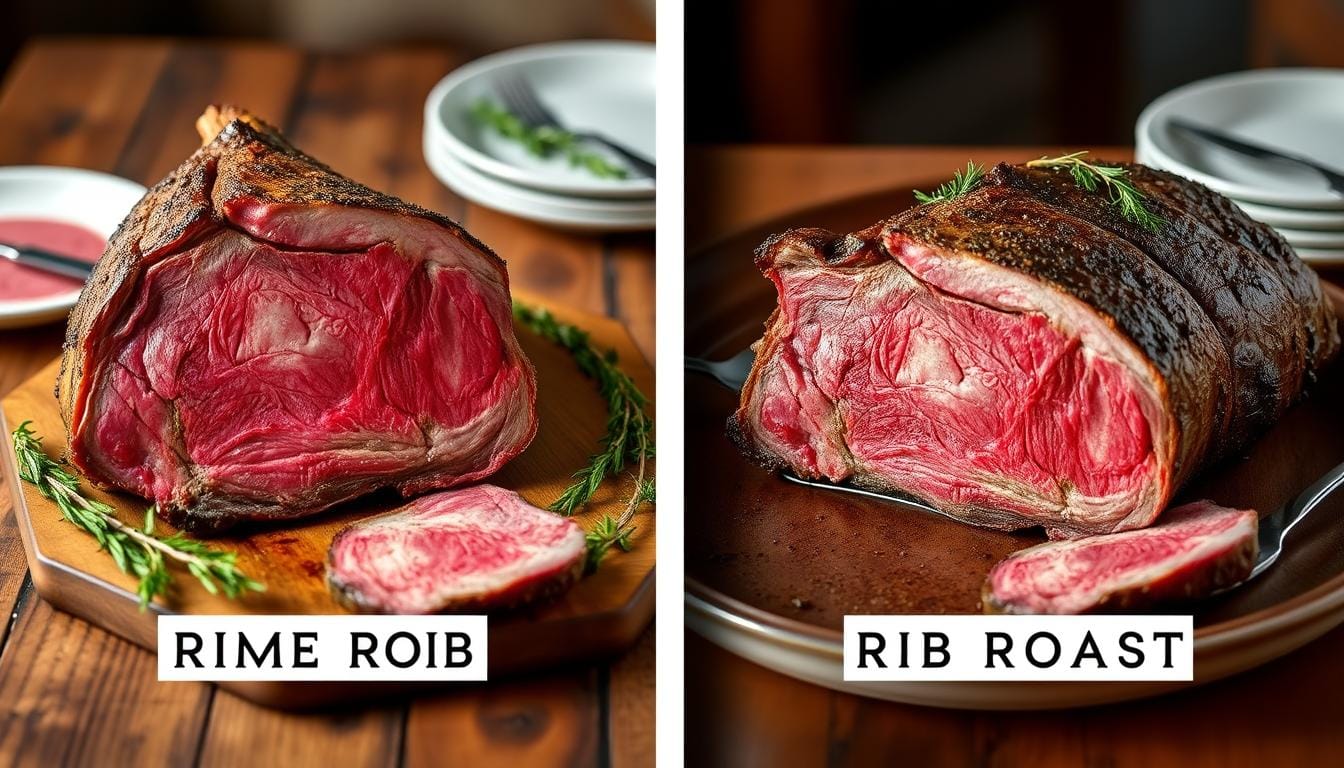The sizzle of a perfectly cooked beef cut can turn a simple dinner into a memorable feast. Whether it’s for a holiday meal or to impress friends, knowing the difference between rib roast and prime rib can make your dish stand out.
Imagine walking into a butcher’s shop, feeling lost among the many beef cuts. Prime rib vs ribeye roast might seem confusing. But, understanding the small differences can guide you to the perfect choice. Each cut has its own special qualities that can change your meal.
A cow has 13 ribs, offering a world of flavors and textures. The rib roast section, between the short loin and chuck, has many options for beef lovers. From bone-in prime rib to boneless ribeye roast, these cuts are the best of beef.
Choosing between rib roast and prime rib depends on several things. These include cooking method, flavor, portion size, and budget. Knowing these details can turn you from a casual cook to a skilled beef expert.
In this detailed guide, we’ll dive into the world of premium beef cuts. We’ll cover everything you need to know about rib roast vs prime rib. Get ready to become a true beef connoisseur!
Understanding Premium Beef Cuts
Beef offers a wide range of flavors, textures, and quality. It can be confusing. Knowing about beef cuts helps you choose the best prime rib roast or ribeye roast for your meal.

Cattle are divided into eight main sections, each with its own traits. The rib section is especially valued for its taste and quality.
The Primal Sections of Beef
Beef is broken down into main sections:
- Chuck (shoulder area)
- Rib
- Loin
- Round
- Flank
- Short Plate
- Brisket
- Shank
Quality Grades of Beef
The USDA has a grading system for beef quality. It looks at marbling and the animal’s age.
| Grade | Marbling | Typical Use |
|---|---|---|
| Prime | Abundant | High-end restaurants |
| Choice | Moderate | Home cooking |
| Select | Slight | Budget-friendly meals |
The Importance of Marbling
Marbling is the intramuscular fat in beef. It’s key for flavor, tenderness, and the overall taste of prime rib vs ribeye roast.
“Great beef is all about the marbling – it’s the secret to an unforgettable dining experience.”
What Makes Prime Rib Special

Prime rib is a luxurious cut of beef that makes your meal special. It comes from the cow’s ribs 6-12. The name “prime” doesn’t mean it’s graded by the USDA. It means it’s a high-quality cut from a special part of the beef.
This cut is special for many reasons:
- It has a lot of marbling, making it very tender.
- It has a rich, intense beef flavor that’s hard to find elsewhere.
- It’s usually sold with the bone in, which makes it taste better and juicier.
- It’s often the star of special meals.
“A prime rib is not just a meal, it’s a culinary experience that transforms an ordinary dinner into a memorable feast.”
Is a rib roast the same as a prime rib? Not exactly. While they’re similar, prime rib is a more specific and prestigious cut. A full prime rib roast can be up to 30 pounds. Butchers often cut it in half for easier handling.
| Prime Rib Characteristic | Details |
|---|---|
| Weight Range | 14-30 pounds |
| Optimal Cooking Temperature | 120-125°F (rare to medium-rare) |
| Rest Time Before Serving | 20 minutes |
| Total Cooking Time | 1 hour 15 minutes |
Whether it’s for a holiday feast or a special dinner, prime rib offers an unparalleled dining experience. It will impress even the most picky meat lovers.
All About Rib Roast
The rib roast is a top choice in premium beef, known for its rich flavor and versatility. Knowing the difference between rib roast and prime rib can make your cooking and dining better.
Bone-in vs Boneless Options
Rib roast comes in two main types: bone-in and boneless. The bone-in version, also known as a standing rib roast, has 7 bones and tastes amazing. On the other hand, a boneless ribeye roast is easier to carve and cooks more evenly.
- Bone-in roasts keep more moisture and taste richer
- Boneless cuts are simpler to prepare and serve
- Butchers suggest tying roasts at 3/4 inch intervals for even cooking
Size and Weight Considerations
Rib roasts can be quite large, up to 25 pounds. But, most home cooks prefer smaller sizes, between 4-8 pounds, for easier handling.
| Roast Size | Estimated Servings | Recommended Cooking Time |
|---|---|---|
| 4-5 pounds | 6-8 people | 2-3 hours |
| 8-10 pounds | 12-16 people | 3-4 hours |
Fat Distribution Patterns
The fat in a rib roast is key to its great taste. You’ll see a fat cap on one side and marbling in the meat. This fat makes the meat rich and juicy, making rib roast a top choice.
“The magic of a perfect rib roast lies in its beautiful fat marbling and careful preparation.” – Professional Chef
When picking a rib roast, look for even fat and consistent color. This ensures a delicious meal that highlights the best of beef.
Rib Roast vs Prime Rib: Key Differences Explained
Exploring beef cuts can make your cooking better. Knowing the difference between rib roast and prime rib is key. They share some traits but also have unique qualities that affect taste, cooking, and serving.
- Cut Location: Prime rib comes from ribs 6-12. Rib roast can come from the whole 13-rib section.
- Bone Configuration: Prime rib is usually bone-in. Rib roast can be either bone-in or boneless.
- Cooking Approach: Prime rib needs slow roasting. Rib roast can be cooked in various ways.
When you ask “Can you use rib roast for prime rib?”, the answer is a bit complex. While they’re similar, they’re not the same because of meat quality and cooking methods.
| Characteristic | Prime Rib | Rib Roast |
|---|---|---|
| Typical Weight | 4-6 pounds | 2-4 pounds |
| Cooking Time | 20-25 minutes per pound | 15-20 minutes per pound |
| Recommended Internal Temp | 130°-140° (Medium Rare) | 125°-135° (Medium Rare) |
Choosing between prime or choice rib roast depends on your budget and taste preferences. Prime cuts are better for special events because of their marbling and tenderness.
“The difference is in the details: understanding your cut can transform an ordinary meal into an extraordinary dining experience.”
Both cuts can make a meal delicious if cooked right and with the right techniques.
Butchery Techniques and Cut Locations
Learning about beef butchery helps you choose better between prime rib and ribeye roast. Cutting beef is an art that affects its taste, texture, and quality.
Butchers pick certain parts of the beef for top cuts like prime rib and rib roast. Where the cut comes from greatly affects its qualities.
Prime Rib: Precision in the Rib Section
Prime rib is a special cut from a specific beef part. Here’s why it stands out:
- Cut from ribs 6-12 of the primal rib section
- Often left bone-in to boost flavor
- Usually more marbled and tender
Rib Roast: The Broader Primal Cut
Comparing rib roast to prime rib shows some key differences in butchery:
- Can be from the whole 13-rib primal section
- More often sold without bones
- Texture and fat content vary by location
“The art of butchery is about understanding each cut’s unique characteristics and potential.” – Professional Butcher
The exact spot in the rib section greatly influences the meat’s taste. Ribs 6-9 have more fat and connective tissue, leading to a richer flavor.
Price Comparison and Value Analysis
Understanding the price difference between prime rib and rib roast is key to making a smart choice. Why is rib roast cheaper than ribeye? Several factors affect beef prices.
When comparing prime rib vs ribeye, you’ll see big price differences. These differences come from:
- Beef grade quality
- Cut location
- Bone-in vs boneless options
- Seasonal demand
Beef pricing shows interesting trends:
“Prime rib demand has grown over the past two decades despite rising beef prices.”
| Beef Cut | Average Price per Pound | Holiday Demand |
|---|---|---|
| Prime Rib | $17.99 | 70% of annual sales |
| Rib Roast | $12.50 | 30% of annual sales |
Interestingly, 33 million pounds of prime rib are sold during holidays. The price gap comes from marbling, aging, and butchering methods.
For your meal budget, consider these tips:
1. Buy during off-peak seasons
2. Look for sales at local butcher shops
3. Compare prices across different meat grades
Your choice between prime rib and rib roast depends on your budget, serving size, and taste preferences.
Flavor Profiles and Texture Differences
Exploring prime rib vs ribeye roast reveals their unique flavors. Each cut offers a distinct taste that can enhance your cooking. This is key for meat lovers.
The Impact of Bone-in Cooking
Bone-in cooking changes prime rib’s flavor. The bone enhances the meat’s taste, making it richer. This is a big difference when comparing rib roast and prime rib.
- Bone-in cuts retain more moisture
- Enhanced natural meat flavors
- More complex taste development
Fat Content and Taste Nuances
Nutritional data shows interesting facts about these beef cuts. Prime rib has:
- 290 kcal per 100g
- 22g of protein
- 23g total fat
- 9g saturated fat
- 2.5 mg of iron
“The marbling makes the magic happen in premium beef cuts.” – Professional Chef
Ribeye roast is leaner, with 217 kcal per 100g and 15g of total fat. The fat’s distribution affects tenderness and flavor.
Texture Variations
Prime rib’s texture varies by section. Ribs 6-9 are robust and flavorful. Ribs 10-12 are softer and more delicate. Your choice depends on taste and cooking method.
Cooking Methods and Techniques
Mastering the art of cooking prime rib roast and rib roast needs precision and knowledge of different techniques. Whether you’re wondering if you can use rib roast for prime rib or comparing prime rib roast vs ribeye roast, knowing the right cooking method is key for perfect results.
The secret to a spectacular roast is careful preparation and temperature control. Here are essential cooking techniques to elevate your beef:
- Prep time: 3-5 hours total cooking and resting
- Seasoning with kosher salt and fresh ground black pepper
- Use an instant-read thermometer for precise doneness
“The secret to a perfect roast is patience and precision temperature management.”
Temperature guidelines for optimal doneness include:
| Doneness | Temperature | Internal Temp After Resting |
|---|---|---|
| Medium Rare | 125°F (52°C) | 130-134°F (55-57°C) |
| Medium | 130°F (54°C) | 135-140°F (58-60°C) |
Pro cooking tips for your roast:
- Chill the roast to 30°F (-1°C) before searing
- Sear in a skillet at 400°F (204°C) for 2½ minutes per side
- Roast in oven at 225°F (107°C)
- Rest for 30 minutes after cooking
Remember, the 500 rule can be a game-changer: Cook at 500 degrees for 5-6 minutes per pound, then turn off the oven and let it sit for two hours.
Size and Serving Recommendations
Planning a perfect beef feast means thinking about portion sizes and how many guests you’ll have. When choosing between rib roast and prime rib, knowing how much to serve is key for a memorable meal.
Your choice of meat affects how much to serve. Prime rib has specific guidelines to make sure everyone gets a tasty piece.
Portion Planning Strategies
When cooking prime rib or rib roast, keep these serving tips in mind:
- Bone-in cuts: Plan for 1 pound per person
- Boneless cuts: Estimate 3/4 pound per person
- Holiday buffet: Reduce to 1/2 pound per guest
Guest Count Considerations
Here’s a guide for your prime rib vs ribeye party:
| Number of Guests | Recommended Roast Weight | Approximate Bones |
|---|---|---|
| 3-4 people | 4 pounds | 2 bones |
| 5-6 people | 6 pounds | 3 bones |
| 8-10 people | 10 pounds | 5 bones |
Pro tip: A digital meat thermometer helps ensure precise cooking and prevents overcooking your premium beef cut.
“The right portion makes all the difference between a good meal and an extraordinary dining experience.”
Remember, rib roast and prime rib are flexible in serving. You can adjust based on your specific gathering’s needs and appetites.
Shopping Tips and Selection Guide
Shopping for prime rib or rib roast can be tricky. Is a rib roast the same as a prime rib? Not quite. They come from the same cut but are prepared and presented differently.
To decide between prime and choice rib roast, consider these points:
- Marbling quality
- USDA grading
- Bone-in or boneless options
- Intended cooking method
“The secret to an exceptional roast lies in selecting the right cut and understanding its characteristics.”
For the best selection, focus on these key aspects:
| Selection Criteria | Prime Rib | Rib Roast |
|---|---|---|
| USDA Grade | Typically USDA Prime | Can be Prime, Choice, or Select |
| Recommended Ribs | Ribs 6-12 | Full primal section |
| Bone Preference | Often bone-in | Bone-in or boneless |
Here are some pro tips for shopping:
- Talk to your butcher about what you need
- Choose cuts with consistent marbling
- Buy during sales to save money
- Order early for holidays to get what you want
Choosing the right prime rib or rib roast is key. It’s what makes a special occasion or family dinner unforgettable.
Storage and Preparation Best Practices
Preparing and storing your prime rib vs ribeye roast needs careful attention. Whether it’s a rib roast or prime rib, proper handling is key for a great meal.
Temperature Management
Temperature control is crucial when storing premium beef cuts. Keep your rib roast vs prime rib in the fridge at 40°F or below. This keeps food safe and quality high. The USDA says strict temperatures stop bacteria from growing.
- Refrigerate immediately after purchase
- Store in the coldest part of the refrigerator
- Use within 3-5 days of buying
Aging Considerations
Aging changes the flavor and tenderness of beef. Prime beef, especially, needs careful aging.
| Aging Method | Duration | Flavor Impact |
|---|---|---|
| Dry Aging | 14-28 days | Intense, nutty flavor |
| Wet Aging | 7-14 days | Milder taste |
“The art of aging beef is about patience and precision.” – Master Butcher
Preparation Tips
Before cooking, take your prime rib vs ribeye roast out of the fridge 1-2 hours early. This lets it warm up to room temperature. This makes it cook evenly and stay tender.
- Pat the meat dry with paper towels
- Season generously
- Let rest at room temperature
Pro tip: Always slice against the grain for maximum tenderness when serving your rib roast or prime rib.
For a deeper dive into the art of preparing and understanding prime rib and rib roast, check out these essential resources. Learn how to create the perfect rotisserie prime rib roast for a juicy, flavorful feast with this detailed guide. If you’re curious about how prime rib compares to ribeye roast, explore this comprehensive comparison. For a modern twist, discover the secrets of using sous vide to achieve a tender, evenly cooked result in your prime rib with this sous vide recipe. These resources will elevate your understanding and help you make the most out of these premium cuts.
Conclusion
Choosing between rib roast and prime rib comes down to what you like, how you cook, and the occasion. Prime beef is known for its tenderness and rich flavor. This makes it perfect for special meals.
Deciding between these cuts depends on your cooking needs. The first cut of prime rib is tender, while the second has more fat for flavor. Think about cooking time, budget, and how done you like your meat.
Your choice affects the taste and quality of your meal. Both cuts can make a meal memorable if cooked right. Knowing the differences in marbling and fat helps make your meal stand out.


3 thoughts on “Rib Roast vs. Prime Rib: What’s the Difference and Which One to Choose?”